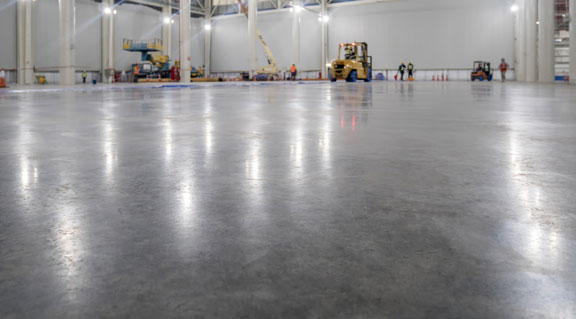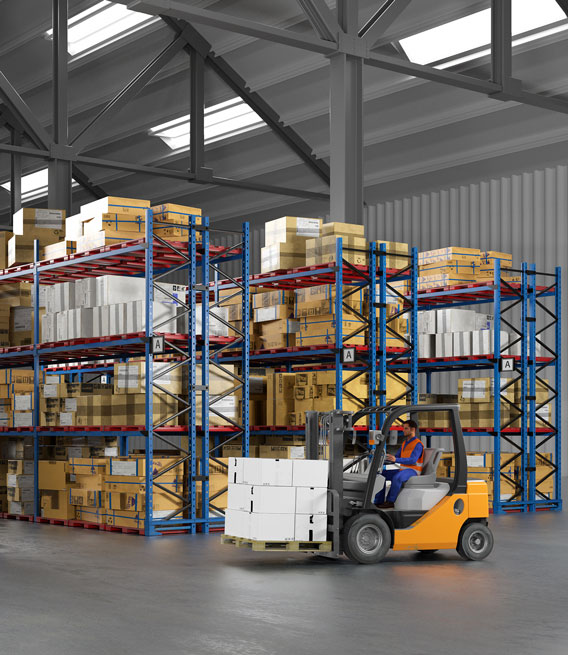Warehouses are a harsh environment filled with heavy equipment, high foot and vehicle traffic, and large storage capacity. These locations need a floor that can handle a warehouse’s demands without wearing down quickly or being damaged easily. That’s why we’re here to provide state-of-the-art concrete polishing services. Concrete polishing drastically improves the attributes of a concrete floor, from increasing its durability to its longevity to much more! Our company has provided quality polished concrete floors to home and business owners across Los Angeles and the surrounding area for years! If you need quality polished concrete floors, we’re the people to call.

Not getting the most out of your warehouse floor?
Switch to a durable polished concrete floor today!
Many warehouses simply use a bare concrete floor for their facility. However, bare concrete isn't always up to the task. Polished concrete can save your warehouse from premature repairs or replacements over the years thanks to its ability to hold up against the harshest environments.

The Concrete Polishing
Process
The process for polishing concrete is designed to strengthen and harden your existing concrete. To get started, we clean the floor and inspect it for any damage, such as cracking or chipping, that could spread and compromise the concrete’s structural integrity. We don’t have to repair minor blemishes or damage, like small pits or holes. These blemishes will be ground out during the next step. To repair cracks, we’ll use an injectable epoxy to fill the gaps and stop them from spreading. Any chipped areas can be fixed using a concrete patch. With the repairs completed, we can move on to the next step.
The next step in the concrete polishing process is the rough grind. This is accomplished using a floor grinder equipped with a diamond grinding wheel.
We start the rough grind with a coarse grit grinding wheel, typically around a 30 to 40-grit wheel. We generally make about three to four passes to ensure that the concrete’s profile is correct for your needs and that any blemishes or light stains are ground out. In most cases, the final pass is with a 150-grit grinding wheel. Once the rough grind is finished, we can seal the concrete. This is done using an impregnating sealer that seals the inside and outside of the concrete while densifying and hardening it. After the sealer has had time to dry, we can begin the actual polishing of the floor. We swap the coarse grinding wheel out for a fine polishing wheel and start with either a 100 or 200-grit polishing wheel. This step is made up of about four or five passes, depending on the sheen level you want for the finished floor. Our team will finish the polishing with either a 1,500 or 3,000-grit polishing wheel. If you wish for a glossier floor, we finish with a 3,000-grit. Now that the final polishing pass has been made, your new warehouse floor is ready for use!
Why Bare Concrete
Is Bad for Warehouse Floors
Not to imply that bare concrete flooring is a bad choice all around, but it may not be the best-suited flooring choice for warehouses.
Though one of the more robust flooring material choices on the market, plain concrete has a few faults when it comes to warehouse flooring. Warehouses are bustling work environments subject to high volumes of both foot and vehicle traffic. Standard concrete can quickly wear down from this constant use and form cracked or chipped areas throughout the floor. These spaces are also frequently used for the storage of bulky goods or equipment. That constant load can put undue stress on the concrete floor that can, over the years, compromise its structural integrity. It’s by no means unheard of to drop tools, equipment, or any other heavy object on occasion in the workplace. However, even one accident such as this can damage a bare concrete floor, causing cracks, dents, or chips in the concrete. If liquids or chemicals are being stored in a warehouse, spills become a new problem altogether. Any liquid spilled onto a bare concrete floor can soak into the concrete, causing stains, damage, and even soaking through to the ground below. With all of these elements combined, bare concrete isn’t the best choice for a warehouse floor. Polished concrete, on the other hand, is the ideal choice. This unique flooring system can handle all of these factors, and more!

The Benefits of Polished Concrete
When some people think of polished concrete, they think that it’s all about the looks and that the floor is simply a beautified concrete floor. However, that’s simply not the case. Polished concrete floors offer a range of benefits that other traditional floors cannot compete with!

Enhanced Durability
Polished concrete is one of the most durable flooring systems in the business! This robust floor can handle various hard impacts, rough abrasions, and high volumes of foot and vehicle traffic without the threat of being damaged or wearing down quickly!
Increased Longevity
Many conventional flooring systems have a lifespan of around 10 to 15 years before they need to be replaced. In contrast, the concrete polishing process significantly increases the lifespan of a concrete floor! When properly installed and maintained, a polished concrete floor will last your business 25 years or more!
Superior Chemical Resistance
A wide range of chemicals can easily damage most traditional floors. Polished concrete is much denser and nonporous than these systems. When a spill occurs, it can be wiped up appropriately without the worry of staining, damaging, or permeating the polished concrete floor.
Ease of Maintenance
When you’re running a warehouse, the last thing that you want to worry about is spending hours trying to clean the floor. Polished concrete requires remarkably little maintenance to keep looking and performing flawlessly. Daily sweeping or dust mopping, spot mopping, and weekly wet mopping are all that’s needed to maintain polished concrete.
Slip Resistance
Slip-and-fall injuries can be a problem in any work environment. Polished concrete offers enhanced slip resistance compared to many other flooring materials, despite its glossy appearance. The polishing process actually increases its friction coefficient, making it much more slip resistant than standard concrete.

